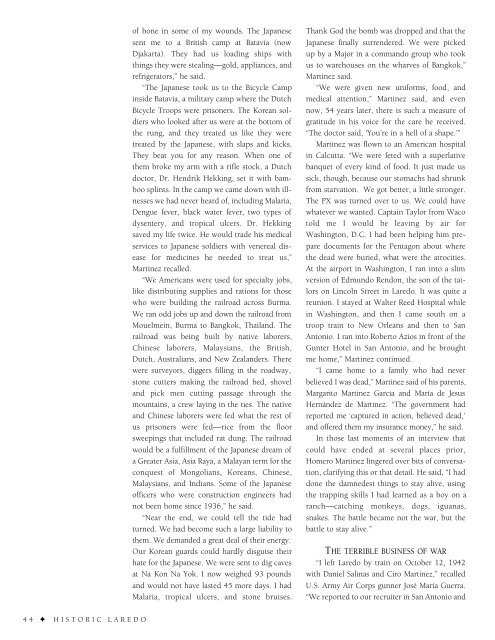Historic Laredo
An illustrated history of the city of Laredo and the Webb County area, paired with the histories of companies, families and organizations that make the region great.
An illustrated history of the city of Laredo and the Webb County area, paired with the histories of companies, families and organizations that make the region great.
Create successful ePaper yourself
Turn your PDF publications into a flip-book with our unique Google optimized e-Paper software.
of bone in some of my wounds. The Japanese<br />
sent me to a British camp at Batavia (now<br />
Djakarta). They had us loading ships with<br />
things they were stealing—gold, appliances, and<br />
refrigerators,” he said.<br />
“The Japanese took us to the Bicycle Camp<br />
inside Batavia, a military camp where the Dutch<br />
Bicycle Troops were prisoners. The Korean soldiers<br />
who looked after us were at the bottom of<br />
the rung, and they treated us like they were<br />
treated by the Japanese, with slaps and kicks.<br />
They beat you for any reason. When one of<br />
them broke my arm with a rifle stock, a Dutch<br />
doctor, Dr. Hendrik Hekking, set it with bamboo<br />
splints. In the camp we came down with illnesses<br />
we had never heard of, including Malaria,<br />
Dengue fever, black water fever, two types of<br />
dysentery, and tropical ulcers. Dr. Hekking<br />
saved my life twice. He would trade his medical<br />
services to Japanese soldiers with venereal disease<br />
for medicines he needed to treat us,”<br />
Martinez recalled.<br />
“We Americans were used for specialty jobs,<br />
like distributing supplies and rations for those<br />
who were building the railroad across Burma.<br />
We ran odd jobs up and down the railroad from<br />
Mouelmein, Burma to Bangkok, Thailand. The<br />
railroad was being built by native laborers,<br />
Chinese laborers, Malaysians, the British,<br />
Dutch, Australians, and New Zealanders. There<br />
were surveyors, diggers filling in the roadway,<br />
stone cutters making the railroad bed, shovel<br />
and pick men cutting passage through the<br />
mountains, a crew laying in the ties. The native<br />
and Chinese laborers were fed what the rest of<br />
us prisoners were fed—rice from the floor<br />
sweepings that included rat dung. The railroad<br />
would be a fulfillment of the Japanese dream of<br />
a Greater Asia, Asia Raya, a Malayan term for the<br />
conquest of Mongolians, Koreans, Chinese,<br />
Malaysians, and Indians. Some of the Japanese<br />
officers who were construction engineers had<br />
not been home since 1936,” he said.<br />
“Near the end, we could tell the tide had<br />
turned. We had become such a large liability to<br />
them. We demanded a great deal of their energy.<br />
Our Korean guards could hardly disguise their<br />
hate for the Japanese. We were sent to dig caves<br />
at Na Kon Na Yok. I now weighed 93 pounds<br />
and would not have lasted 45 more days. I had<br />
Malaria, tropical ulcers, and stone bruises.<br />
Thank God the bomb was dropped and that the<br />
Japanese finally surrendered. We were picked<br />
up by a Major in a commando group who took<br />
us to warehouses on the wharves of Bangkok,”<br />
Martinez said.<br />
“We were given new uniforms, food, and<br />
medical attention,” Martinez said, and even<br />
now, 54 years later, there is such a measure of<br />
gratitude in his voice for the care he received.<br />
“The doctor said, ‘You’re in a hell of a shape.’”<br />
Martinez was flown to an American hospital<br />
in Calcutta. “We were feted with a superlative<br />
banquet of every kind of food. It just made us<br />
sick, though, because our stomachs had shrunk<br />
from starvation. We got better, a little stronger.<br />
The PX was turned over to us. We could have<br />
whatever we wanted. Captain Taylor from Waco<br />
told me I would be leaving by air for<br />
Washington, D.C. I had been helping him prepare<br />
documents for the Pentagon about where<br />
the dead were buried, what were the atrocities.<br />
At the airport in Washington, I ran into a slim<br />
version of Edmundo Rendon, the son of the tailors<br />
on Lincoln Street in <strong>Laredo</strong>. It was quite a<br />
reunion. I stayed at Walter Reed Hospital while<br />
in Washington, and then I came south on a<br />
troop train to New Orleans and then to San<br />
Antonio. I ran into Roberto Azios in front of the<br />
Gunter Hotel in San Antonio, and he brought<br />
me home,” Martinez continued.<br />
“I came home to a family who had never<br />
believed I was dead,” Martinez said of his parents,<br />
Margarito Martinez García and María de Jesus<br />
Hernández de Martinez. “The government had<br />
reported me ‘captured in action, believed dead,’<br />
and offered them my insurance money,” he said.<br />
In those last moments of an interview that<br />
could have ended at several places prior,<br />
Homero Martinez lingered over bits of conversation,<br />
clarifying this or that detail. He said, “I had<br />
done the damnedest things to stay alive, using<br />
the trapping skills I had learned as a boy on a<br />
ranch—catching monkeys, dogs, iguanas,<br />
snakes. The battle became not the war, but the<br />
battle to stay alive.”<br />
THE TERRIBLE BUSINESS OF WAR<br />
“I left <strong>Laredo</strong> by train on October 12, 1942<br />
with Daniel Salinas and Ciro Martinez,” recalled<br />
U.S. Army Air Corps gunner José María Guerra.<br />
“We reported to our recruiter in San Antonio and<br />
44 ✦ HISTORIC LAREDO
















